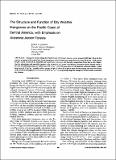| dc.contributor.author | Jiménez, Jorge | |
| dc.date.accessioned | 2020-10-26T20:43:27Z | |
| dc.date.available | 2020-10-26T20:43:27Z | |
| dc.date.issued | 2013 | |
| dc.identifier.uri | http://hdl.handle.net/11056/18437 | |
| dc.description.abstract | Mangrove forests along the Pacific Coast of Central America cover around 4,000 km2. Most of this coast is occupied with tropical dry forest mangroves where basal areas range between 6 and 20 m2 ha−1 and canopy heights rarely exceed 20 m. Rainfall and runoff alter structure and floristic composition from site to site. Reproductive phenology and mortality appear to be related to soil water availability. Avicennia bicolor forests reach a density of 4,350 plants that are taller than 0.50 m ha−1, with 769 trees above 5 cm diameter at breast height A total basal area of 41 m2 ha−1 together with a canopy height of about 23 m place these forests among the most developed in the western hemisphere. Growth rate (0.38 m2 ha−1 yr−1) is surprisingly high for mangrove forests under a seasonal dry climate. | es_ES |
| dc.description.abstract | Los bosques de manglares a lo largo de la costa del Pacífico de América Central cubren alrededor de 4.000 km2. La mayor parte de esta costa está ocupada por manglares de bosque seco tropical donde las áreas basales oscilan entre 6 y 20 m2 ha-1 y las alturas del dosel rara vez superan los 20 m. La lluvia y la escorrentía alteran la estructura y la composición florística de un sitio a otro. La fenología reproductiva y la mortalidad parecen estar relacionadas con la disponibilidad de agua del suelo. Los bosques de Avicennia bicolor alcanzan una densidad de 4,350 plantas que superan los 0,50 m ha − 1, con 769 árboles de más de 5 cm de diámetro a la altura del pecho.Un área basal total de 41 m2 ha − 1 junto con una altura de copa de unos 23 m colocan estos bosques entre los más desarrollados del hemisferio occidental. La tasa de crecimiento (0,38 m2 ha − 1 año − 1) es sorprendentemente alta para los bosques de manglares en un clima estacionalmente seco. | es_ES |
| dc.description.sponsorship | Universidad Nacional, Costa Rica | es_ES |
| dc.language.iso | eng | es_ES |
| dc.publisher | Estuaries Research Federation | es_ES |
| dc.rights | Acceso abierto | es_ES |
| dc.source | Estuaries and coasts vol.13 no.2 182-192 1990 | es_ES |
| dc.subject | BOSQUES | es_ES |
| dc.subject | MANGLARES | es_ES |
| dc.subject | BOSQUE TROPICAL SECO | es_ES |
| dc.subject | AMÉRICA CENTRAL | es_ES |
| dc.subject | MANGROVES | es_ES |
| dc.subject | PACIFIC COAST | es_ES |
| dc.subject | FOREST | es_ES |
| dc.title | The structure and function of dry weather mangrove on the Pacific Coast of Central America, with emphasis on Avicennia bicolor forests | es_ES |
| dc.type | http://purl.org/coar/resource_type/c_6501 | es_ES |
| dc.description.procedence | Escuela de Ciencias Biológicas | es_ES |
| dc.identifier.doi | 10.2307/1351588 | |

